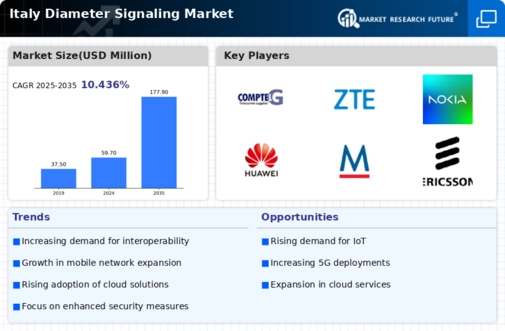Growing Focus on Data Analytics
The growing focus on data analytics within the diameter signaling market in Italy is reshaping how telecommunications companies operate. By leveraging advanced analytics, operators can gain insights into user behavior, network performance, and service quality. This trend is particularly relevant as the volume of data generated by mobile users continues to rise, with estimates suggesting a 30% increase in data traffic annually. Consequently, companies are investing in diameter signaling solutions that incorporate analytics capabilities, allowing for proactive network management and enhanced customer experiences. The market is projected to grow at a rate of 10% per year as businesses recognize the value of data-driven decision-making in optimizing their signaling processes.
Regulatory Compliance and Standards
In Italy, the diameter signaling market is significantly influenced by the need for regulatory compliance and adherence to industry standards. The Italian government, along with EU regulations, mandates stringent guidelines for telecommunications and data privacy. This regulatory landscape compels service providers to implement robust signaling solutions that ensure compliance with laws such as GDPR. As a result, the diameter signaling market is witnessing increased investments in technologies that facilitate compliance, thereby enhancing operational efficiency. The market is expected to see a growth rate of around 12% annually as companies prioritize compliance-driven solutions. This trend not only mitigates legal risks but also fosters consumer trust, which is essential for long-term business sustainability.
Increased Investment in Cybersecurity
The diameter signaling market in Italy is witnessing increased investment in cybersecurity measures. As cyber threats become more sophisticated, telecommunications companies are prioritizing the protection of their signaling networks. This focus on security is driven by the need to safeguard sensitive customer data and maintain service integrity. Reports indicate that cybersecurity spending in the telecommunications sector is expected to reach €1.5 billion by 2026. This trend is prompting operators to adopt advanced diameter signaling solutions that incorporate robust security features, thereby mitigating risks associated with data breaches and service disruptions. The emphasis on cybersecurity is likely to propel the diameter signaling market forward, as companies seek to enhance their resilience against evolving threats.
Rising Demand for Enhanced Connectivity
The diameter signaling market in Italy is experiencing a notable surge in demand for enhanced connectivity solutions. As businesses and consumers increasingly rely on seamless communication, the need for robust signaling protocols becomes paramount. This demand is driven by the proliferation of IoT devices, which are expected to reach over 50 million units in Italy by 2026. Consequently, service providers are investing in advanced diameter signaling solutions to manage the growing data traffic efficiently. The market is projected to grow at a CAGR of approximately 15% from 2025 to 2030, indicating a strong trajectory for the diameter signaling market. This growth is further fueled by the necessity for real-time data processing and improved user experiences, compelling operators to adopt innovative signaling technologies.
Expansion of Mobile Network Infrastructure
The expansion of mobile network infrastructure in Italy is a critical driver for the diameter signaling market. With the ongoing rollout of 5G networks, telecommunications companies are upgrading their signaling systems to support higher data rates and lower latency. This transition is expected to result in an investment of approximately €3 billion in network infrastructure by 2027. The diameter signaling market is poised to benefit from this expansion, as enhanced signaling capabilities are essential for managing the increased complexity of 5G networks. Furthermore, the integration of advanced signaling solutions will enable operators to optimize network performance and improve service delivery, thereby attracting more subscribers and increasing revenue streams.




















Leave a Comment